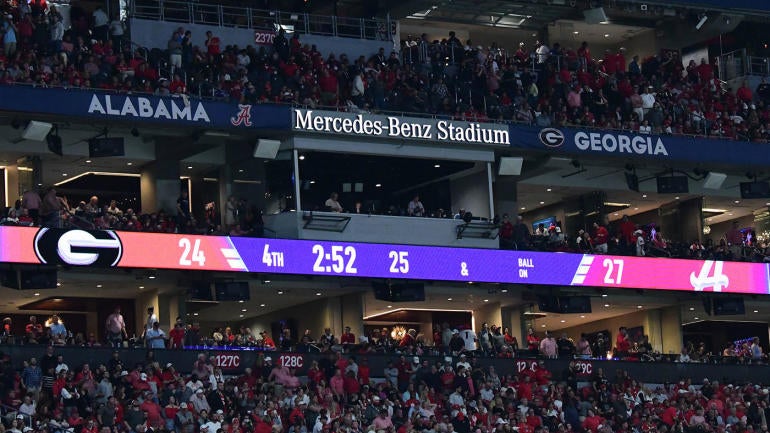
It's easy to get confused when conference media days are going on at the same time as a political convention. Both events are full of people lying to your face, hoping you won't take the time to fact check. At SEC Media Days, for example, coaches and administrators alike echoed a sentiment that the SEC plays a lot of one-score games.
I was initially skeptical, but everybody seemed so confident about it, so I had to check. Football Scoop's Zach Barnett did some surface research, comparing the SEC last season to the Big 12, but I decided to go deeper. I looked at every conference in the College Football Playoff era (since 2014), throwing out the COVID-shortened 2020 season (it was a season full of outliers that only skew reality), to see how many one-score games each league played and how many games finished with a margin of three scores or more (17 or more points).
Does the SEC play a lot of one-score games? It depends on the context. Since 2014, 188 matchups between teams have finished as one-score games. That's a lot! However, there were 588 total SEC games, meaning 37.01% of SEC's games finished within a score. It's not an insignificant amount, but it was below average compared to the rest of college football.
| Conference | One-score games/total games | Rate |
|---|---|---|
Big 12 | 179/423 | 42.32% |
ACC | 214/507 | 42.21% |
MAC | 183/441 | 41.50% |
Sun Belt | 161/412 | 39.08% |
FBS Average | 1,797/4,660 | 38.56% |
Pac-12 | 188/488 | 38.52% |
Mountain West | 161/435 | 37.01% |
SEC | 188/508 | 37.01% |
American | 157/429 | 36.60% |
Conference USA | 168/462 | 36.36% |
Big Ten | 198/555 | 35.68% |
It's always nice when the data backs up your instinct, which is precisely what happens here with the Big 12. There's been plenty of talk about how competitive the new iteration of the Big 12 will be now that Oklahoma and Texas have left. Still, it turns out the Big 12 was already one of the most competitive leagues on a weekly basis with those two. What remains to be seen is if that 42.32% rate of one-score games will increase now that the Longhorns and Sooners are gone.
What surprised me was that the ACC is right on the Big 12's heels, though it makes sense upon reflection. Clemson has been the most dominant ACC program of the CFP era, but everybody else in the league has struggled to pull away from one another. For example: Florida State went undefeated in the regular season and won the ACC last year, but that season stood out because the Seminoles have been mostly mired in mediocrity ever since appearing in the first College Football Playoff.
On the other end of the spectrum is the Big Ten. If a Big Ten coach or administrator boasts about the number of one-score games at next week's media days in Indianapolis, call them a liar right to their face. Not only has the Big Ten played the lowest rate of one-score games, but it's done so by a considerable margin. In fact, games between Big Ten teams have produced the highest percentage of blowouts (17-plus points).
| Conference | Blowouts/games | Rate |
|---|---|---|
ACC | 191/507 | 37.67% |
MAC | 168/441 | 38.10% |
Big 12 | 168/423 | 39.72% |
Mountain West | 173/435 | 39.77% |
Sun Belt | 171/412 | 41.50% |
FBS Average | 1,937/4,660 | 41.57% |
Pac-12 | 204/488 | 41.80% |
SEC | 217/508 | 42.72% |
American | 185/429 | 43.12% |
Conference USA | 200/462 | 43.29% |
Big Ten | 260/555 | 46.85% |
Not only does the Big Ten have the most blowouts by our standard, but their 46.85% rate is 3.56 points higher than the closest league, Conference USA! That's nearly the same size gap between the ACC (lowest at 37.67%) and the fifth-lowest, the Sun Belt (41.50%).
It's interesting to note that the Big 12 plays more one-score games but also has a higher rate of blowouts than the ACC; however, they are two of only three conferences to play more one-score games than blowouts, with the MAC being the third.
On average, FBS conference games see more blowouts (41.57%) than they do one-score games (38.56).
How all of this could change in the new 12-team CFP era remains to be seen, but you have to think both the SEC and Big Ten (and the networks who broadcast their games) are hoping expansion will lead to more competitive games overall. Perhaps that's what was happening at SEC Media Days: they weren't declaring it as much as they were hoping to speak it into existence.
















